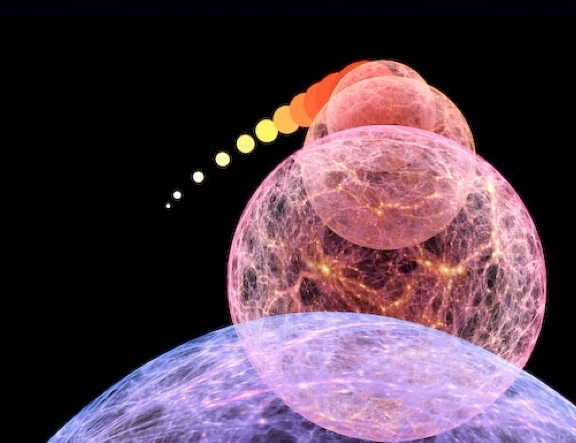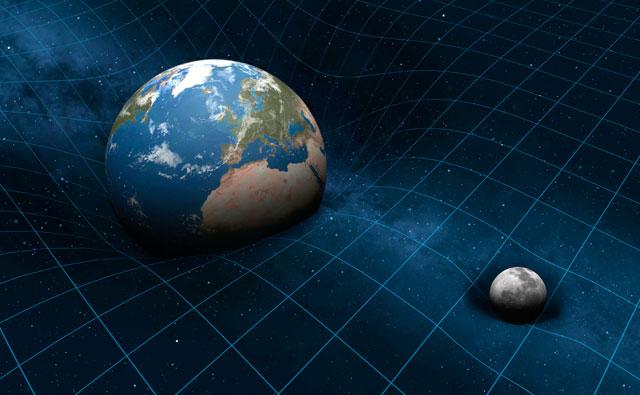Dark energy, accelerated expansion and conservation of energy: how does all this fit together?
I have long had the opinion that those who manifest themselves in various forms of matter forces have one source. Or, in other words, they are so directly connected and mutually dependent on each other, that they can turn into each other, and the energy of their actions is equivalent.
- Michael Faraday
For hundreds of years, there was an idea that one cannot get something from nothing, and it appeared long before we learned about the most important conservation law in the Universe: the energy conservation law.

For example, a ball rolling from a hill, gaining speed and kinetic energy, does not receive them from nowhere! It turns into a kinetic other form of energy - the gravitational potential. And at any moment of the journey the total amount of energy - its kinetic and potential - remains unchanged.
')
When considering a closed system, one that cannot receive energy from the outside or lose it, the energy conservation law works perfectly.

Earth, for example, is not a closed system. It receives light and energy from everywhere from the Universe, mainly from the Sun, and also radiates energy into space. The sun is also not a closed system, since it constantly radiates energy into space, but this energy is also not taken from nowhere. It is created by converting the energy of the rest mass into light and heat (and neutrinos) through nuclear fusion and E = mc 2 . If you include all sources of outgoing and incoming energy for any system in the Universe, the law of conservation works.

And although there are certain strange quantum phenomena that at first glance violate this law, on scales from subatomic to cosmic, but if you count all the incoming and outgoing energy, the law will continue to work anyway.
How can we then answer the question of one of the astrophysicists:
What is the source of energy for an accelerating universe?
Awesome question in depth. Let's start with what it means to live in an accelerating universe.

One can imagine the early Universe - at least its observable part - as a hot, dense and rapidly expanding sphere of matter and energy. But it is also known that if your universe is filled with matter and energy, then the force of gravity will do everything it can to pull this expanding universe back. Therefore, to put it simply, we get the following: an initially rapidly expanding Universe, which gravity is trying to slow down, reverse, and again lead to collapse.
In the picture above, the left diagram represents the expanding Universe in which gravity won. Initial expansion is not enough for the existing matter and energy, and the Universe eventually reverses the expansion and collapses in Great Compression. The second image shows the Universe, which lacked only one subatomic particle for recompression. In this case, the expansion rate will decrease, asymptotically tending to zero, but not reaching it. The third case, the Low Density Universe, continues to expand forever, since the gravitational pull of all matter and radiation is unable to withstand the initial expansion.

It remains the fourth, the actual case of the accelerating universe. This Universe is filled with dark energy, or the final positive vacuum energy inherent in the space itself. And in this case, the expansion of the Universe is not just “not slowing down enough” for a collapse to occur - it is so large that distant galaxies are moving away from us faster and faster! This means that if we take the finite sphere of matter and energy and let it expand, its radius will increase as follows:

Our Universe is different from the case of re-collapse (orange). It is not similar to the critical (green) case, nor to the case of low density (blue). Our Universe is increasing at an exponential rate, as the red curve shows. According to the best measurements, the energy density of the cosmos (the density of dark energy) does not increase and does not decrease, but remains constant.
But it may confuse you. If the energy density is constant and space expands, does this violate the law of conservation of energy? In other words, do we not produce more and more energy over time, which should actually be conserved?

Technically, it is possible to get out of this complexity, noting that the picture I have given is not quite true. The large-scale Universe is governed by the General Theory of Relativity, a protruding theory of gravity. Strictly speaking, energy is not defined in GR, so why worry about its conservation? But there is a tricky way to consider "energy", allowing us to prove its conservation even in such a paradoxical situation.
Remember that in addition to chemical, electrical, thermal, kinetic and potential energy, there is also work.

Vasily Ivanovich Alekseev - Soviet weightlifter, two-time Olympic champion and eight-time world champion
In physics, work is the application of force to an object directed to the same place where the object moves. This means that if you apply a force directed upwards to the load moving upwards, you are doing a positive job (adding energy to the system). But if you apply an upward force to a load moving downward, you do negative work (remove energy from the system).
It is easier to imagine if you put a book on your hand and raise or lower it.

When you push in the direction of the book’s movement, you do a positive job and add energy to the system. When you push in the opposite direction, you do negative work.
Now back to the universe. You have an expanding spherical object, and a sphere of constant density (dark energy) fills the sphere. You are a positive energy. With the help of gravity, this sphere is inward. But what does the sphere do?

It expands. In other words, you pull in the opposite direction of expansion, and do negative work. Then why is the expansion accelerated? Of course, the positive density of dark energy means that it is attracted to all matter in the Universe, but the rate of expansion depends on the magnitude of its negative pressure. And, answering the question, where does the energy for the “dark energy” come from, we can say that it comes from the negative work done on the expanding Universe!
More technically speaking, like Carroll, Press and Turner in 1992:
This section does negative work on its environment, since its pressure is negative. If we assume that it expands adiabatically, we can equate this negative work with an increase in the mass / energy of the site. Thus you can get the correct equation of the state of dark energy:
So with math everything is in order. This is how energy can be saved even in the Universe filled with dark energy!
Source: https://habr.com/ru/post/370075/
All Articles